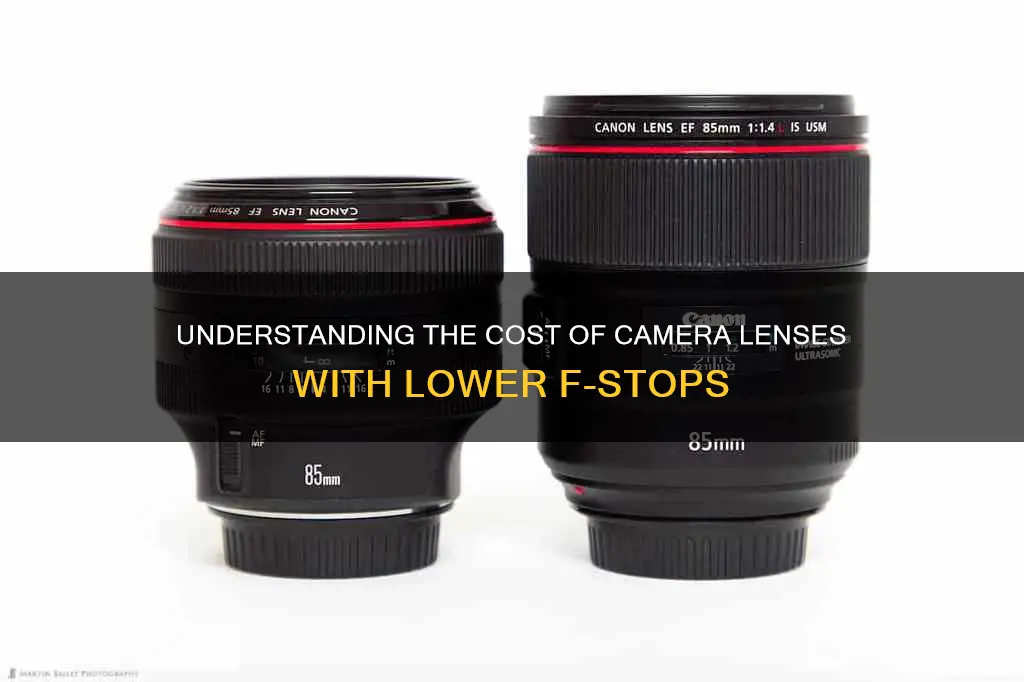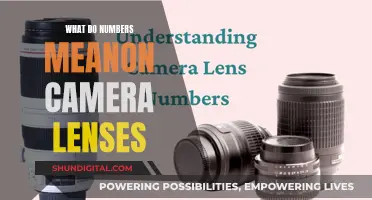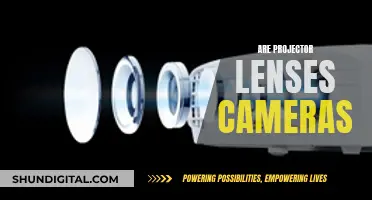
Camera lenses with lower f-stops are more expensive because they are heavier, have a larger aperture, and are more complex to manufacture. The aperture, or f-stop, is the ratio of the lens focal length to the diameter of the entrance pupil. A lower f-stop means a larger aperture, which requires a larger lens. This increase in size results in more costly materials and a heavier lens. Additionally, the optics of a fast lens with a lower f-stop are more complex, requiring more elements and a more intricate design. The cost of manufacturing these lenses is, therefore, higher, which is reflected in the retail price.
What You'll Learn
- Lenses with lower f-stops let more light in, which is useful in low-light conditions
- The aperture is the ratio of the lens focal length to the diameter of the entrance pupil
- The maximum aperture of a lens is often included in the name of the lens
- Lenses with lower f-stops are heavier
- Lenses with lower f-stops are more expensive because they are more difficult to manufacture

Lenses with lower f-stops let more light in, which is useful in low-light conditions
Lenses with lower f-stops are able to let in more light, which is extremely useful in low-light conditions. This is because the f-stop, or f-number, is the ratio of the lens focal length to the diameter of the entrance pupil. The lower the f-number, the larger the aperture, and the more light the lens lets in. This is why lenses with lower f-stops are so important for photographers who often find themselves shooting in darker conditions.
The amount of light a lens can let in is directly related to the size of the aperture. A larger aperture will let in more light, and a smaller aperture will let in less light. This is why lenses with lower f-stops are so valuable to photographers who often work in low-light conditions. They allow these photographers to let more light into their camera, which can help to improve the quality of their photos in dark settings.
The impact of aperture on the amount of light that reaches the camera sensor is significant. For example, a lens with a maximum aperture of f/2.8 will let in twice as much light as a lens with a maximum aperture of f/4.0. This is why lenses with lower f-stops are often more expensive; they offer a feature that is highly sought-after by photographers who work in darker environments.
The aperture of a lens also has a significant impact on depth of field – the amount of a photo that appears sharp from front to back. A larger aperture will result in a shallower depth of field, while a smaller aperture will result in a greater depth of field. This means that lenses with lower f-stops are not only useful for letting in more light, but also for creating a pleasant "shallow focus" effect, where only a thin slice of the subject is sharp. This is often desired by portrait photographers, who want to ensure that their subject's eyes are in focus while the background is blurred.
Lenses with lower f-stops offer a range of creative opportunities for photographers, from improving low-light photography to creating shallow depth of field effects. It is important to note that while lenses with lower f-stops can be extremely useful, they may not be necessary for all photographers. The specific needs and requirements of an individual photographer should be considered when deciding whether to invest in a lens with a lower f-stop.
Understanding Camera Lenses: Capturing Unique Perspectives
You may want to see also

The aperture is the ratio of the lens focal length to the diameter of the entrance pupil
Lenses with lower f-numbers are heavier and more expensive. They focus faster, blur the background better, and allow you to handhold the camera in less light. The extra cost and weight are worth it for professionals, but amateurs can start with an inexpensive lens and upgrade when they feel limited by the maximum aperture.
The Intriguing Pricing of Camera Lenses: Factors and Features
You may want to see also

The maximum aperture of a lens is often included in the name of the lens
The maximum aperture of a lens is also referred to as the "wide-open" aperture. Typically, the maximum aperture of a lens will be something like f/1.4, f/1.8, f/2, f/2.8, f/3.5, f/4, or f/5.6. Photographers who need to shoot in low-light conditions without a tripod will want to use a large aperture, something like f/1.8 or f/3.5.
The maximum aperture of a lens is important for another reason, too: depth of field. A large aperture like f/1.4 has a very thin depth of field, which is why portrait photographers like them so much. Landscape photographers, on the other hand, prefer using smaller apertures, like f/8, f/11, or f/16, to capture both the foreground and background of a scene as sharp as possible at the same time.
Interchangeable Lenses: What Camera Bodies Support Them?
You may want to see also

Lenses with lower f-stops are heavier
The f-stop or aperture is the ratio of the lens focal length to the front diameter. For example, a lens with a focal length of 100mm and a maximum aperture of f/2 would require a 50mm diameter front element. If the focal length is doubled to 200mm while maintaining the same f-stop, the front element diameter would double, resulting in an eightfold increase in weight.
Additionally, the larger front element requires more expensive, specially coated glass. The manufacturing process for these large glass elements is also more complex and costly.
The weight increase is particularly noticeable in telephoto lenses. For instance, the Canon 400mm lens with an f-stop of f/5.6 weighs 2.8 lbs, while the same lens with an f-stop of f/2.8 weighs 11.8 lbs.
The heavier weight of lenses with lower f-stops is a significant factor contributing to their higher cost.
Repairing Moto X4 Camera Lenses: A Step-by-Step Guide
You may want to see also

Lenses with lower f-stops are more expensive because they are more difficult to manufacture
The lower the f-stop, the larger the lens needs to be, requiring more specially coated and complex glass. This is because the f-number is the ratio of the lens focal length to the diameter of the entrance pupil. A lower f-number means a larger entrance pupil diameter in relation to the focal length. As the entrance pupil gets larger, so too must the lens diameter, which increases the amount of material required.
Additionally, the lower the f-stop, the more difficult it is to control lens aberrations that reduce image quality. This requires more sophisticated designs, exotic materials, and more expensive engineering. The optics of a fast lens are more complex as they have to be able to focus light more broadly through a larger opening. This often requires more lens elements, which in turn adds weight and cost.
The cost of manufacturing these lenses is further compounded by the fact that they are often in higher demand by professionals, which boosts the price as manufacturers can justify the use of better materials and more complex designs.
Recognizing Sigma Camera Lenses: A Quick Guide to Identification
You may want to see also
Frequently asked questions
Camera lenses with lower f-stops cost more because they are heavier, and they are more complex to design and engineer.
Camera lenses with lower f-stops let in more light, focus faster, blur the background better, and allow you to handhold the camera in less light.
Camera lenses with higher f-stops are cheaper and lighter, but they require more light to take a photo, and they have a slower shutter speed.
An f-stop is the ratio of the lens focal length to the diameter of the entrance pupil. It is written as a fraction, so f/2 is a larger aperture than f/16, for example.







